This is an old revision of this page, as edited by Somaliphone (talk | contribs) at 01:29, 18 August 2024 (→Consonants: I fixed the table.). The present address (URL) is a permanent link to this revision, which may differ significantly from the current revision.
Revision as of 01:29, 18 August 2024 by Somaliphone (talk | contribs) (→Consonants: I fixed the table.)(diff) ← Previous revision | Latest revision (diff) | Newer revision → (diff) Cushitic language of the Horn of Africa Not to be confused with Somali languages.| Somali | |
|---|---|
| Af Soomaali, Soomaali 𐒖𐒍 𐒈𐒝𐒑𐒛𐒐𐒘, 𐒈𐒝𐒑𐒛𐒐𐒘 اف صومالِ, صومالِ, | |
| Pronunciation | [af soːmaːli] |
| Region | Horn of Africa |
| Ethnicity | Somalis |
| Native speakers | 24 million (2019–2023) |
| Language family | Afro-Asiatic |
| Dialects | Northern Benadiri Ashraf Maay |
| Writing system | Somali Latin alphabet (Latin script; official) Wadaad's writing (Arabic script) Osmanya alphabet Borama alphabet Kaddare alphabet |
| Official status | |
| Official language in | |
| Recognised minority language in | |
| Regulated by | Regional Somali Language Academy |
| Language codes | |
| ISO 639-1 | so |
| ISO 639-2 | som |
| ISO 639-3 | som |
| Glottolog | soma1255 |
| Linguasphere | 14-GAG-a |
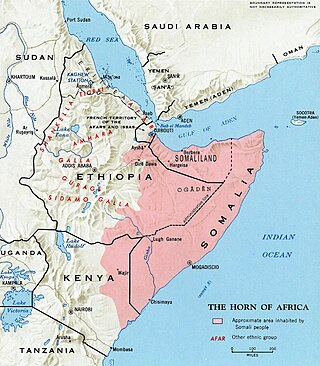 Primary Somali Sprachraum Primary Somali Sprachraum | |
| This article contains IPA phonetic symbols. Without proper rendering support, you may see question marks, boxes, or other symbols instead of Unicode characters. For an introductory guide on IPA symbols, see Help:IPA. | |
Somali (/səˈmɑːli, soʊ-/ sə-MAH-lee, soh-; Latin script: Af-Soomaali; Wadaad: اف صومالِ; Osmanya: 𐒖𐒍 𐒈𐒝𐒑𐒛𐒐𐒘 [af soːmaːli]) is an Afroasiatic language belonging to the Cushitic branch. It is spoken primarily in Greater Somalia, and by the Somali diaspora as a mother tongue. Somali is an official language in both Somalia and Ethiopia, and serves as a national language in Djibouti, it is also a recognised minority language in Kenya. The Somali language is officially written with the Latin alphabet although the Arabic script and several Somali scripts like Osmanya, Kaddare and the Borama script are informally used.
Classification
Main articles: Afroasiatic languages and Cushitic languagesSomali is classified within the Cushitic branch of the Afroasiatic family, specifically, Lowland East Cushitic in addition to Afar and Saho. Somali is the best-documented of the Cushitic languages, with academic studies of the language dating back to the late 19th century.
Geographic distribution of Somali
The Somali language is spoken in Somali inhabited areas of Somalia, Djibouti, Ethiopia, Kenya, Yemen and by members of the Somali diaspora. It is also spoken as an adoptive language by a few ethnic minority groups and individuals in Somali majority regions.
Somali is the most widely spoken Cushitic language in the region followed by Oromo and Afar.
As of 2021, there are approximately 24 million speakers of Somali, spread in Greater Somalia of which around 17 million reside in Somalia. The language is spoken by an estimated 95% of the country's inhabitants, and also by a majority of the population in Djibouti.
Following the start of the Somali Civil War in the early 1990s, the Somali-speaking diaspora increased in size, with newer Somali speech communities forming in parts of the Middle East, North America and Europe.
Official status
 |
| Part of a series on the |
| Culture of Somalia |
|---|
| Culture |
| People |
| Religion |
| Language |
| Politics |
Constitutionally, Somali and Arabic are the two official languages of Somalia. Somali has been an official national language since January 1973, when the Supreme Revolutionary Council (SRC) declared it the Somali Democratic Republic's primary language of administration and education. Somali was thereafter established as the main language of academic instruction in forms 1 through 4, following preparatory work by the government-appointed Somali Language Committee. It later expanded to include all 12 forms in 1979. In 1972, the SRC adopted a Latin orthography as the official national alphabet over several other writing scripts that were then in use. Concurrently, the Italian-language daily newspaper Stella d'Ottobre ("The October Star") was nationalized, renamed to Xiddigta Oktoobar, and began publishing in Somali. The state-run Radio Mogadishu has also broadcast in Somali since 1951. Additionally, other state-run public networks like Somaliland National TV, regional public networks such as Puntland TV and Radio and, as well as Eastern Television Network and Horn Cable Television, among other private broadcasters, air programs in Somali.
Somali is recognized as an official working language in the Somali Region of Ethiopia. Although it is not an official language of Djibouti, it constitutes a major national language there. Somali is used in television and radio broadcasts, with the government-operated Radio Djibouti transmitting programs in the language from 1943 onwards.
The Kenya Broadcasting Corporation also broadcasts in the Somali language in its Iftin FM Programmes. The language is spoken in the Somali territories within North Eastern Kenya, namely Wajir County, Garissa County and Mandera County.
The Somali language is regulated by the Regional Somali Language Academy, an intergovernmental institution established in June 2013 in Djibouti City by the governments of Djibouti, Somalia and Ethiopia. It is officially mandated with preserving the Somali language.
As of October 2022, Somali and Oromo are the only Cushitic languages available on Google Translate.
Varieties
Main articles: Somali languages, Northern Somali, and Benadiri Somali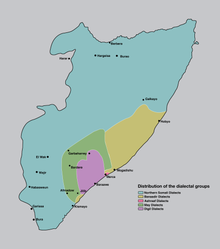
The Somali languages are broadly divided into three main groups: Northern Somali, Benadir and Maay. Northern Somali forms the basis for Standard Somali. It is spoken by the majority of the Somali population with its speech area stretching from Djibouti, and the Somali Region of Ethiopia to the Northern Frontier District. This widespread modern distribution is a result of a long series of southward population movements over the past ten centuries from the Gulf of Aden littoral. Lamberti subdivides Northern Somali into three dialects: Northern Somali proper (spoken in the northwest; he describes this dialect as Northern Somali in the proper sense), the Darod group (spoken in the northeast and along the eastern Ethiopia frontier; greatest number of speakers overall), and the Lower Juba group (spoken by northern Somali settlers in the southern riverine areas).
Benadir (also known as Coastal Somali) is spoken on the central Indian Ocean seaboard, including Mogadishu. It forms a relatively smaller group. The dialect is fairly mutually intelligible with Northern Somali.
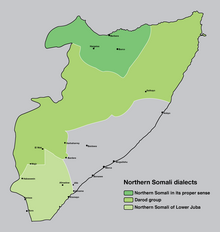
Phonology
Main article: Somali phonologyVowels
The language has five basic vowels.
| Front | Central | Back | |
|---|---|---|---|
| High | i ⟨i⟩ iː ⟨ii⟩ | u ⟨u⟩ uː ⟨uu⟩ | |
| Mid | e ⟨e⟩ eː ⟨ee⟩ | o ⟨o⟩ oː ⟨oo⟩ | |
| Low | a ⟨a⟩ aː ⟨aa⟩ |
Consonants
Somali has 22 consonant phonemes.
| Bilabial | Coronal | Post- alveolar |
Velar | Uvular | Pharyn- geal |
Glottal | ||
|---|---|---|---|---|---|---|---|---|
| Nasal | m ⟨m⟩ | n ⟨n⟩ | ||||||
| Plosive | voiceless | t̪ ⟨t⟩ | k ⟨k⟩ | q ⟨q⟩ | ʔ ⟨'⟩ | |||
| voiced | b ⟨b⟩ | d̪ ⟨d⟩ | ɖ ⟨dh⟩ | ɡ ⟨g⟩ | ||||
| Affricate | d͡ʒ ⟨j⟩ | |||||||
| Fricative | voiceless | f ⟨f⟩ | s ⟨s⟩ | ʃ ⟨sh⟩ | x ⟨kh⟩ | (χ) | ħ ⟨x⟩ | h ⟨h⟩ |
| voiced | ʕ ⟨c⟩ | |||||||
| Trill | r ⟨r⟩ | (ɽ) | ||||||
| Approximant | l ⟨l⟩ | j ⟨y⟩ | w ⟨w⟩ | |||||
- ^† The consonants /b d̪ ɡ/ often weaken to intervocalically.
The retroflex plosive /ɖ/ may have an implosive quality for some Somali Bantu speakers, and intervocalically it can be realized as the flap . Some speakers produce /ħ/ with epiglottal trilling. /q/ is often epiglottalized.
The letter ⟨dh⟩ is a retroflex flap when it is pronounced intervocalically, hence becoming the phoneme (ɽ): for example, Quraanjo (Ant) from Qudhaanjo; But however, more often than not is the pronouncement of ɽ to the unretained-retroflex ɾ.
The letter ⟨kh⟩ is rarely pronounced as a velar fricative, Partially the reason why is that it is mostly found in Arabic loanwords. It is pronounced as the phoneme χ when it is an allophone for the letter ⟨q⟩ in syllabic codas. As in Akhri from Aqri meaning (read).
Tone
Pitch is phonemic in Somali, but it is debated whether Somali is a pitch accent, or it is a tonal language. Andrzejewski (1954) posits that Somali is a tonal language, whereas Banti (1988) suggests that it is a pitch system.
Phonotactics
The syllable structure of Somali is (C)V(C).
Root morphemes usually have a mono- or di-syllabic structure.
Clusters of two consonants do not occur word-initially or word-finally, i.e., they only occur at syllable boundaries. The following consonants can be geminate: /b/, /d/, /ɖ/, /ɡ/, /ɢ/, /m/, /n/, /r/ and /l/. The following cannot be geminate: /t/, /k/ and the fricatives.
Two vowels cannot occur together at syllable boundaries. Epenthetic consonants, e.g. and , are therefore inserted.
Grammar
Main article: Somali grammar| Person | Emphatic | Clitic (short) | |||
|---|---|---|---|---|---|
| Subject | Object | ||||
| 1 | singular | aniga | aan | i | |
| plural | inclusive | innaga | aynu | ina | |
| exclusive | annaga | aannu | na | ||
| 2 | singular | adiga | aad | ku | |
| plural | idinka | aydin | idin | ||
| 3 | singular | masculine | isaga | uu | -- |
| feminine | iyada | ay | -- | ||
| plural | iyaga | ay | -- | ||
Morphology
Somali is an agglutinative language, and also shows properties of inflection. Affixes mark many grammatical meanings, including aspect, tense and case.
Somali has an old prefixal verbal inflection restricted to four common verbs, with all other verbs undergoing inflection by more obvious suffixation. This general pattern is similar to the stem alternation that typifies Cairene Arabic.
Somali has two sets of pronouns: independent (substantive, emphatic) pronouns and clitic (verbal) pronouns. The independent pronouns behave grammatically as nouns, and normally occur with the suffixed article -ka/-ta (e.g. adiga, "you"). This article may be omitted after a conjunction or focus word. For example, adna meaning "and you..." (from adi-na). Clitic pronouns are attached to the verb and do not take nominal morphology. Somali marks clusivity in the first person plural pronouns; this is also found in a number of other East Cushitic languages, such as Rendille and Dhaasanac.
As in various other Afro-Asiatic languages, Somali is characterized by polarity of gender, whereby plural nouns usually take the opposite gender agreement of their singular forms. For example, the plural of the masculine noun dibi ("bull") is formed by converting it into feminine dibi. Somali is unusual among the world's languages in that the object is unmarked for case while the subject is marked, though this feature is found in other Cushitic languages such as Oromo.
Syntax
Somali is a subject–object–verb (SOV) language. It is largely head final, with postpositions and with obliques preceding verbs. These are common features of the Cushitic and Semitic Afroasiatic languages spoken in the Horn region (e.g. Amharic). However, Somali noun phrases are head-initial, whereby the noun precedes its modifying adjective. This pattern of general head-finality with head-initial noun phrases is also found in other Cushitic languages (e.g. Oromo), but not generally in Ethiopian Semitic languages.
Somali uses three focus markers: baa, ayaa and waxa(a), which generally mark new information or contrastive emphasis. Baa and ayaa require the focused element to occur preverbally, while waxa(a) may be used following the verb.
Vocabulary
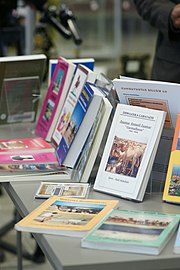
Somali loanwords can be divided into those derived from other Afroasiatic languages (mainly Arabic), and those of Indo-European extraction (mainly Italian).
Somali's main lexical borrowings come from Arabic, and are estimated to constitute about 20% of the language's vocabulary. This is a legacy of the Somali people's extensive social, cultural, commercial and religious links and contacts with nearby populations in the Arabian peninsula. Arabic loanwords are most commonly used in religious, administrative and education-related speech (e.g. aamiin for "faith in God"), though they are also present in other areas (e.g. kubbad-da, "ball"). Soravia (1994) noted a total of 1,436 Arabic loanwords in Agostini a.o. 1985, a prominent 40,000-entry Somali dictionary. Most of the terms consisted of commonly used nouns. These lexical borrowings may have been more extensive in the past since a few words that Zaborski (1967:122) observed in the older literature were absent in Agostini's later work. In addition, the majority of personal names are derived from Arabic.
The Somali language also contains a few Indo-European loanwords that were retained from the colonial period. Most of these lexical borrowings come from English and Italian and are used to describe modern concepts (e.g. telefishen-ka, "the television"; raadia-ha, "the radio"). There are 300 loan words from Italian, such as garawati for "tie" (from Italian cravatta), dimuqraadi from democratico (democratic), mikroskoob from microscopio, and so on.
Additionally, Somali contains lexical terms from Persian, Urdu and Hindi that were acquired through historical trade with communities in the Near East and South Asia (e.g. khiyaar "cucumber" from Template:Lang-fa khiyār ). Other loan words have also displaced their native synonyms in some dialects (e.g. jabaati "a type of flat bread" from Hindi: चपाती chapāti displacing sabaayad). Some of these words were also borrowed indirectly via Arabic.
As part of a broader governmental effort of linguistic purism in the Somali language, the past few decades have seen a push in Somalia toward replacement of loanwords in general with their Somali equivalents or neologisms. To this end, the Supreme Revolutionary Council during its tenure officially prohibited the borrowing and use of English and Italian terms.
Writing system
Main article: Somali alphabets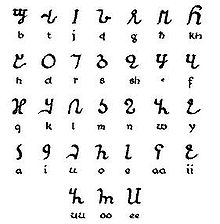

Archaeological excavations and research in Somalia uncovered ancient inscriptions in a distinct writing system. In an 1878 report to the Royal Geographical Society of Great Britain, scientist Johann Maria Hildebrandt noted upon visiting the area that "we know from ancient authors that these districts, at present so desert, were formerly populous and civilised I also discovered ancient ruins and rock-inscriptions both in pictures and characters These have hitherto not been deciphered." According to the 1974 report for Ministry of Information and National Guidance, this script represents the earliest written attestation of Somali.
Much more recently, Somali archaeologist Sada Mire has published ancient inscriptions found throughout Somaliland. As much for much of Somali linguistic history the language was not widely used for literature, Dr. Mire's publications however prove that writing as a technology was not foreign nor scarce in the region. These piece of writing are from the Semitic Himyarite and Sabaean languages that were largely spoken in what is modern day Yemen —"there is an extensive and ancient relationship between the people and cultures of both sides of the Red Sea coast" Mire posits. Yet, while many more such ancient inscriptions are yet to be found or analyzed, many have been "bulldozed by developers, as the Ministry of Tourism could not buy the land or stop the destruction".
Besides Ahmed's Latin script, other orthographies that have been used for centuries for writing the Somali language include the long-established Arabic script and Wadaad's writing. According to Bogumił Andrzejewski, this usage was limited to Somali clerics and their associates, as sheikhs preferred to write in the liturgical Arabic language. Various such historical manuscripts in Somali nonetheless exist, which mainly consist of Islamic poems (qasidas), recitations and chants. Among these texts are the Somali poems by Sheikh Uways and Sheikh Ismaaciil Faarah. The rest of the existing historical literature in Somali principally consists of translations of documents from Arabic.
Since then a number of writing systems have been used for transcribing the Somali language. Of these, the Somali Latin alphabet, officially adopted in 1972, is the most widely used and recognised as official orthography of the state. The script was developed by a number of leading scholars of Somali, including Musa Haji Ismail Galal, B. W. Andrzejewski and Shire Jama Ahmed specifically for transcribing the Somali language, and uses all letters of the English Latin alphabet except p, v and z. There are no diacritics or other special characters except the use of the apostrophe for the glottal stop, which does not occur word-initially. There are three consonant digraphs: DH, KH and SH. Tone is not marked, and front and back vowels are not distinguished.
Writing systems developed in the twentieth century include the Osmanya, Borama and Kaddare alphabets, which were invented by Osman Yusuf Kenadid, Abdurahman Sheikh Nuur and Hussein Sheikh Ahmed Kaddare, respectively.
Numbers and calendrical terms
| This section does not cite any sources. Please help improve this section by adding citations to reliable sources. Unsourced material may be challenged and removed. (June 2020) (Learn how and when to remove this message) |
Numbers
| English | Somali | ||
|---|---|---|---|
| Latin | Osmanya | # | |
| Zero | Eber | 𐒗𐒁𐒗𐒇 | 𐒠 |
| One | kow | 𐒏𐒙𐒓 | 𐒡 |
| Two | laba | 𐒐𐒖𐒁𐒖 | 𐒢 |
| Three | saddex | 𐒈𐒖𐒆𐒆𐒗𐒄 | 𐒣 |
| Four | afar | 𐒖𐒍𐒖𐒇 | 𐒤 |
| Five | shan | 𐒉𐒖𐒒 | 𐒥 |
| Six | lix | 𐒐𐒘𐒄 | 𐒦 |
| Seven | toddoba | 𐒂𐒙𐒆𐒆𐒙𐒁𐒖 | 𐒧 |
| Eight | siddeed | 𐒈𐒘𐒆𐒆𐒜𐒆 | 𐒨 |
| Nine | sagaal | 𐒈𐒖𐒌𐒛𐒐 | 𐒩 |
| Ten | toban | 𐒂𐒙𐒁𐒖𐒒 | 𐒡𐒠 |
| English | Somali | ||
|---|---|---|---|
| Latin | Osmanya | # | |
| Eleven | kow iyo toban | 𐒏𐒙𐒓 𐒘𐒕𐒙 𐒂𐒙𐒁𐒖𐒒 | 𐒡𐒡 |
| Twelve | laba iyo toban | 𐒐𐒖𐒁𐒖 𐒘𐒕𐒙 𐒂𐒙𐒁𐒖𐒒 | 𐒡𐒢 |
| Thirteen | saddex iyo toban | 𐒈𐒖𐒆𐒆𐒗𐒄 𐒘𐒕𐒙 𐒂𐒙𐒁𐒖𐒒 | 𐒡𐒣 |
| Fourteen | afar iyo toban | 𐒖𐒍𐒖𐒇 𐒘𐒕𐒙 𐒂𐒙𐒁𐒖𐒒 | 𐒡𐒤 |
| Fifteen | shan iyo toban | 𐒉𐒖𐒒 𐒘𐒕𐒙 𐒂𐒙𐒁𐒖𐒒 | 𐒡𐒥 |
| Sixteen | lix iyo toban | 𐒐𐒘𐒄 𐒘𐒕𐒙 𐒂𐒙𐒁𐒖𐒒 | 𐒡𐒦 |
| Seventeen | toddoba iyo toban | 𐒂𐒙𐒆𐒆𐒙𐒁𐒖 𐒘𐒕𐒙 𐒂𐒙𐒁𐒖𐒒 | 𐒡𐒧 |
| Eighteen | sideed iyo toban | 𐒈𐒘𐒆𐒜𐒆 𐒘𐒕𐒙 𐒂𐒙𐒁𐒖𐒒 | 𐒡𐒨 |
| Nineteen | sagaal iyo toban | 𐒈𐒖𐒌𐒛𐒐 𐒘𐒕𐒙 𐒂𐒙𐒁𐒖𐒒 | 𐒡𐒩 |
| Twenty | labaatan | 𐒐𐒖𐒁𐒛𐒂𐒖𐒒 | 𐒢𐒠 |
For all numbers between 11 kow iyo toban and 99 sagaashal iyo sagaal, it is equally correct to switch the placement of the numbers, although larger numbers is some dialects prefer to place the 10s numeral first. For example 25 may both be written as labaatan iyo shan and shan iyo labaatan (lit. Twenty and Five & Five and Twenty).
Although neither the Latin nor Osmanya scripts accommodate this numerical switching.
Multiples of 10
| English | Somali | ||
|---|---|---|---|
| Latin | Osmanya | # | |
| Ten | toban | 𐒂𐒙𐒁𐒖𐒒 | 𐒡𐒠 |
| Twenty | labaatan | 𐒐𐒖𐒁𐒛𐒂𐒖𐒒 | 𐒢𐒠 |
| Thirty | soddon | 𐒈𐒙𐒆𐒆𐒙𐒒 | 𐒣𐒠 |
| Forty | afartan | 𐒖𐒍𐒖𐒇𐒂𐒖𐒒 | 𐒤𐒠 |
| Fifty | konton | 𐒏𐒙𐒒𐒂𐒙𐒒 | 𐒥𐒠 |
| Sixty | lixdan | 𐒐𐒘𐒄𐒆𐒖𐒒 | 𐒦𐒠 |
| Seventy | todobaatan | 𐒂𐒙𐒆𐒙𐒁𐒛𐒂𐒖𐒒 | 𐒧𐒠 |
| Eighty | sideetan | 𐒈𐒘𐒆𐒜𐒂𐒖𐒒 | 𐒨𐒠 |
| Ninety | sagaashan | 𐒈𐒖𐒌𐒛𐒉𐒖𐒒 | 𐒩𐒠 |
Names of large numbers
| English | Somali | ||
|---|---|---|---|
| Latin | Osmanya | #* | |
| One hundred | boqol | 𐒁𐒙𐒎𐒙𐒐 | 𐒡𐒠𐒠 |
| One thousand | kun | 𐒏𐒚𐒒 | 𐒡,𐒠𐒠𐒠 |
| One million | milyan | 𐒑𐒘𐒐𐒕𐒖𐒒 | 𐒡,𐒠𐒠𐒠,𐒠𐒠𐒠 |
| One billion | bilyan | 𐒁𐒘𐒐𐒕𐒖𐒒 | 𐒡,𐒠𐒠𐒠,𐒠𐒠𐒠,𐒠𐒠𐒠 |
*the commas in the Osmanya number chart are added for clarity
Days of the week
| English | Somali | |
|---|---|---|
| Latin | Osmanya | |
| Sunday | Axad | 𐒖𐒄𐒖𐒆 |
| Monday | Isniin | 𐒘𐒈𐒒𐒕𐒒 |
| Tuesday | Salaasa/Talaado | 𐒈𐒖𐒐𐒛𐒈𐒖/𐒂𐒖𐒐𐒛𐒆𐒙 |
| Wednesday | Arbaca/Arbaco | 𐒖𐒇𐒁𐒖𐒋𐒛/𐒖𐒇𐒁𐒖𐒋𐒙 |
| Thursday | Khamiis | 𐒅𐒖𐒑𐒕𐒈 |
| Friday | Jimce/Jimco | 𐒃𐒘𐒑𐒋𐒙 |
| Saturday | Sabti | 𐒈𐒖𐒁𐒂𐒘 |
Months of the year
| English | Somali | |
|---|---|---|
| Latin | Osmanya | |
| January | Janaayo | 𐒃𐒜𐒒𐒚𐒓𐒖𐒇𐒘 |
| February | Febraayo | 𐒍𐒛𐒁𐒇𐒚𐒓𐒖𐒇𐒘 |
| March | Maarso | 𐒑𐒛𐒃 |
| April | Abriil | 𐒖𐒁𐒇𐒕𐒐 |
| May | Maajo | 𐒑𐒖𐒕 |
| June | Juun | 𐒃𐒓𐒒 |
| July | Luuliyo | 𐒃𐒓𐒐𐒛𐒕 |
| August | Agoosto | 𐒝𐒌𐒖𐒈 |
| September | Sebteembar | 𐒈𐒘𐒁𐒂𐒖𐒑𐒁𐒖𐒇 |
| October | Oktoobar | 𐒙𐒏𐒂𐒝𐒁𐒖𐒇 |
| November | Nofeembar | 𐒒𐒝𐒍𐒖𐒑𐒁𐒖𐒇 |
| December | Diseembar | 𐒆𐒕𐒈𐒑𐒁𐒖𐒇 |
See also
- Languages of Djibouti
- Languages of Somalia
- Languages of Kenya
- Somali Sign Language
- Somali literature
- Somali Studies
Notes
- The /χ/ phoneme is pronounced as a syllable coda such as in the word: Akhri from Aqri meaning (read) basically.
- The /ɽ/ phoneme is pronounced such intervocally from /ɖ/.
References
- "Somali alphabets, pronunciation and language". Omniglot. Retrieved 16 June 2017.
- "cldr/so.xml at master · unicode-org/cldr". Unicode. Retrieved 8 November 2020.
- ^ "Somali". SIL International. 2021. Retrieved June 28, 2021.
- Jones, Daniel (2003) , Peter Roach; James Hartmann; Jane Setter (eds.), English Pronouncing Dictionary, Cambridge: Cambridge University Press, ISBN 3-12-539683-2
- "Somali". Collins Dictionary. Retrieved 21 September 2013.
- Saeed (1999:107)
- AfricaNews (2020-03-04). "One to five: Ethiopia gets four new federal working languages". Africanews. Archived from the original on 2020-10-28. Retrieved 2021-11-11.
- Lewis, I.M. (1999). A Pastoral Democracy: A Study of Pastoralism and Politics Among the Northern Somali of the Horn of Africa. LIT Verlag Münster. p. 175. ISBN 3825830845.
- Lewis, I.M. (1958), The Gadabuursi Somali Script, Bulletin of the School of Oriental and African Studies, University of London, Vol. 21, pp. 134–156.
- Lewis, I. (1998). Peoples of the Horn of Africa: Somali, Afar and Saho. Red Sea Press. p. 11. ISBN 9781874209829.
- ^ Lecarme & Maury (1987:22)
- ^ Dubnov (2003:9)
- Saeed (1999:3)
- "Somalia | Ethnologue Free". Ethnologue (Free All). Retrieved 2024-03-05.
- "Somali - Worldwide distribution". Worlddata.info. Retrieved 2024-03-05.
- "The Federal Republic of Somalia - Provisional Constitution" (PDF). Archived from the original (PDF) on 24 January 2013. Retrieved 13 March 2013.
- ^ Ammon & Hellinger (1992:128–131)
- "A Guiding Voice Amid the Ruins of a Capital City". The New York Times. March 30, 2010. Archived from the original on August 20, 2023. Retrieved August 25, 2023.
- "Radio Muqdisho". Radio Muqdisho. April 9, 2022. Archived from the original on August 22, 2023. Retrieved August 25, 2023.
- "Somali Media Mapping Report" (PDF). Somali Media Mapping. Retrieved 31 August 2014.
- Kizitus, Mpoche; Mbuh, Tennu, eds. (2006). Language, literature, and identity. Cuvillier. pp. 163–164. ISBN 3-86537-839-0.
- "Ethnologue - Djibouti - Languages". Ethnologue. Retrieved 25 April 2013.
- Dubnov (2003:10)
- Carrier, Neil (2019). Mobile Urbanity Somali Presence in Urban East Africa. Berghahn Books. p. 34. ISBN 9781789202977.
- Archived at Ghostarchive and the Wayback Machine: "KBC yazindua kitua kipya cha redio kwa lugha ya Kisomali". YouTube.
- "Regional Somali Language Academy Launched in Djibouti". COMESA Regional Investment Agency. Archived from the original on 21 January 2015. Retrieved 28 February 2014.
- "Google Translate - now in 80 languages". Google Translate. 10 December 2013. Retrieved 30 December 2013.
- ^ Dalby (1998:571)
- Dalby (1998:571)
- Mundus, Volumes 23-24. Wissenschaftliche Verlagsgesellschaft. 1987. p. 205.
- Andrzejewski & Lewis (1964:6)
- Lamberti, Marcello (1986). Map of Somali dialects in the Somalia Democratic Republic (PDF). H. Buske. ISBN 9783871186905.
- Saeed (1999:4)
- Cite error: The named reference
ipu1982was invoked but never defined (see the help page). - Saeed (1999:7)
- Saeed (1999:7–10)
- Gabbard (2010:6)
- Edmondson, Esling & Harris (2004)
- Edmondson, Esling & Harris (2004:5)
- Saeed (1999:8)
- Gabbard (2010:14)
- Edmondson, Esling & Harris (2004:5)
- Keith Brown, Sarah Ogilvie (2010). Concise Encyclopedia of Languages of the World. Elsevier. p. 987. ISBN 978-0080877754.
- Andrzejewski, Bogumit Witalis (1954). "Is Somali a Tone-language?", Proceedings of the Twenty-Third International Congress of Orientalists. Royal Asiatic Society. pp. 367–368. OCLC 496050266.
- Dubnov (2003:11)
- Kraska, Iwona (2007). Analogy: the relation between lexicon and grammar. Lincom Europa. p. 140. ISBN 978-3895868986.
- ^ Saeed (1999:68)
- Saeed (1999:72)
- Weninger (2011:43)
- ^ Tosco, Mauro; Department of Anthropology; Indiana University (2000). "Is There an "Ethiopian Language Area"?". Anthropological Linguistics. 42 (3): 349. Retrieved 8 May 2013.
- Zwicky & Pullum (1983:389)
- John I. Saeed (1984). The Syntax of Focus & Topic in Somali. H. Buske. p. 66. ISBN 3871186724.
- ^ Heine & Nurse (2000:253)
- Klaus Wedekind, Charlotte Wedekind, Abuzeinab Musa (2007). A learner's grammar of Beja (East Sudan): grammar, texts and vocabulary (Beja-English and English-Beja). Rüdiger Köppe Verlag. p. 10. ISBN 978-3896455727.
{{cite book}}: CS1 maint: multiple names: authors list (link) - Saeed (1999:164, 173)
- Fisiak (1997:53)
- Saeed (1999:117)
- Saeed (1999:240)
- ^ Dubnov (2003:71)
- Laitin (1977:25)
- ^ Versteegh (2008:273)
- Saeed (1999:5)
- Saeed (1999:2)
- ^ Dubnov (2003:73)
- Sheik-ʻAbdi (1993:45)
- ^ Ministry of Information and National Guidance, Somalia, The writing of the Somali language, (Ministry of Information and National Guidance: 1974), p.5
- Royal Geographical Society (Great Britain), Proceedings of the Royal Geographical Society of London, Volume 22, "Mr. J. M. Hildebrandt on his Travels in East Africa", (Edward Stanford: 1878), p. 447.
- ^ Mire, Sada (2015-03-01). "Mapping the Archaeology of Somaliland: Religion, Art, Script, Time, Urbanism, Trade and Empire". African Archaeological Review. 32 (1): 111–136. doi:10.1007/s10437-015-9184-9. ISSN 1572-9842.
- "Somali writing scripts". Omniglot. Retrieved 8 May 2013.
- Andrezewski, B. W. (July 2013). In Praise of Somali Literature. Lulu. pp. 130–131. ISBN 978-1291454536. Retrieved 17 January 2015.
- Andrezewski, B. W. (July 2013). In Praise of Somali Literature. Lulu. p. 232. ISBN 978-1291454536. Retrieved 17 January 2015.
- Economist Intelligence Unit (Great Britain), Middle East annual review, (1975), p.229
- Abdullahi (2001:73)
- Lewis, I. M. (1999). A Pastoral Democracy: A Study of Pastoralism and Politics Among the Northern Somali of the Horn of Africa. James Currey Publishers. ISBN 978-0-85255-280-3.
- Laitin (1977:86–87)
Sources
- Abdullahi, Mohamed Diriye (2001). Culture and Customs of Somalia. Greenwood. ISBN 978-0-313-31333-2.
- Ammon, Ulrich; Hellinger, Marlis (1992). Status Change of Languages. Walter de Gruyter.
- Andrzejewski, B.; Lewis, I. (1964). Somali poetry: an introduction. Clarendon Press.
- Dalby, Andrew (1998). Dictionary of languages: the definitive reference to more than 400 languages. Columbia University Press.
- Dubnov, Helena (2003). A Grammatical Sketch of Somali. Koln: Rudiger Koppe Verlag.
- Edmondson, Jerold A.; Esling, John H.; Harris, Jimmy G. (2004). Supraglottal cavity shape, linguistic register, and other phonetic features of Somali (PDF) (Report). Archived from the original (PDF) on 2012-03-15. Retrieved 2020-11-21.
- Fisiak, Jacek (1997). Linguistic reconstruction and typology. Walter de Gruyter. ISBN 978-3-11-014905-0.
- Gabbard, Kevin (2010), A Phonological Analysis of Somali and the Guttural Consonants (Thesis), The Ohio State University, hdl:1811/46639
- Heine, Bernd; Nurse, Derek (2000). African Languages: An Introduction. Cambridge University Press. ISBN 978-0-521-66629-9.
- Laitin, David (1977). Politics, Language, and Thought: The Somali Experience. University Of Chicago Press.
- Lecarme, Jacqueline; Maury, Carole (1987). "A software tool for research in linguistics and lexicography: Application to Somali". Computers and Translation. 2. Paradigm Press: 21–36. doi:10.1007/BF01540131. S2CID 6515240.
- Saeed, John (1999). Somali. Amsterdam: John Benjamins. ISBN 1-55619-224-X.
- Sheik-ʻAbdi, ʻAbdi ʻAbdulqadir (1993). Divine madness: Moḥammed ʻAbdulle Ḥassan (1856-1920). Zed Books.
- Versteegh, Kees (2008). Encyclopedia of Arabic language and linguistics, Volume 4. Brill. ISBN 978-9004144767.
- Weninger, Stefan (2011). Semitic Languages: An International Handbook. Walter de Gruyter. ISBN 978-3-11-025158-6.
- Zwicky, Arnold; Pullum, Geoffrey (1983). "Phonology in Syntax: The Somali Optional Agreement Rule" (PDF). Natural Language & Linguistic Theory. 1 (3): 385–402. doi:10.1007/bf00142471. S2CID 170420275.
Further reading
- Armstrong, Lilias E. (1969) . The phonetic structure of Somali. Gregg International Publishers. hdl:2307/4698. ISBN 0576-11443-X.
- Bell, C. R. V. (1953). The Somali Language. London: Longmans, Green & Co.
- Berchem, Jörg (1991). Referenzgrammatik des Somali. Köln: Omimee. ISBN 3921008018.
- Cana, Frank Richardson (1911). "Somaliland" . Encyclopædia Britannica. Vol. 25 (11th ed.). pp. 378–384, see page 379.
Inhabitants.—The Somali belong to the Eastern (Abyssinia) Hamitic family.... Their influence has been very slight even on the Somali language, whose structure and vocabulary are essentially Hamitic, with marked affinities to the Galla on the one hand and to the Dankali (Afar) on the other.
- Cardona, G. R. (1981). "Profilo fonologico del somalo". In Cardona, G. R.; Agostini, F. (eds.). Studi Somali I: Fonologia e Lessico (in Italian). Roma: Ministero degli Affari Esteri, Dipartimento per la Cooperazione allo Sviluppo, Comitato Tecnico Linguistico per l'Universita Nazionale Somala. OCLC 15276449.
- Diriye Abdullahi, Mohamed (2000). Le Somali, dialectes et histoire (PhD dissertation) (in French). Université de Montréal. hdl:1866/30162.
- Dobnova, Elena Z. (1990). Sovremennyj somalijskij jazyk. Moskva: Nauka.
- Lamberti, M. (1986). Die Somali-Dialekte. Hamburg: Buske.
- Lamberti, M. (1986). Map of the Somali-Dialects in the Somali Democratic Republic. Hamburg: Buske.
- Puglielli, Annarita (1997). "Somali Phonology". In Kaye, Alan S. (ed.). Phonologies of Asia and Africa. Vol. 1. Winona Lake: Eisenbrauns. pp. 521–535. ISBN 978-1-57506-019-4.
- Saeed, John Ibrahim (1987). Somali Reference Grammar. Springfield, VA: Dunwoody Press. ISBN 0931745330. LCCN 87-073464. OCLC 18561242.
External links
- Somali Language Page: Resources, links and information on the Somali language.
- Hooyo.Web - Somali Grammar
- Somali Language and Linguistics: A Bibliography
- Learn101 - Learn Somali
- Virtual keyboard for historical Osmanya script. Lexilogos.
- Digital Dialects - Somali language learning games
- Enhancing the Quality of Google Somali Translations
| Links to related articles | |||||||||||||||||||||||||||||||||||||||||||||||||||||||||||||||||||||||||||||||||||||||||||||||||||||||||||||||||||||||||||||||||||||||||||||||||||||||||||||||||||||||||||||||||||||||||
|---|---|---|---|---|---|---|---|---|---|---|---|---|---|---|---|---|---|---|---|---|---|---|---|---|---|---|---|---|---|---|---|---|---|---|---|---|---|---|---|---|---|---|---|---|---|---|---|---|---|---|---|---|---|---|---|---|---|---|---|---|---|---|---|---|---|---|---|---|---|---|---|---|---|---|---|---|---|---|---|---|---|---|---|---|---|---|---|---|---|---|---|---|---|---|---|---|---|---|---|---|---|---|---|---|---|---|---|---|---|---|---|---|---|---|---|---|---|---|---|---|---|---|---|---|---|---|---|---|---|---|---|---|---|---|---|---|---|---|---|---|---|---|---|---|---|---|---|---|---|---|---|---|---|---|---|---|---|---|---|---|---|---|---|---|---|---|---|---|---|---|---|---|---|---|---|---|---|---|---|---|---|---|---|---|---|
| |||||||||||||||||||||||||||||||||||||||||||||||||||||||||||||||||||||||||||||||||||||||||||||||||||||||||||||||||||||||||||||||||||||||||||||||||||||||||||||||||||||||||||||||||||||||||